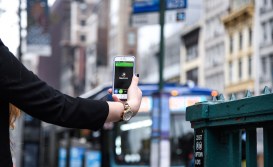New York City doubles subway Wi-Fi service
Waiting for the subway is getting a little less boring in New York City.
The Big Apple’s Metropolitan Transportation Authority has completed the latest phase of its project to enable wireless Internet in all 277 of the city’s underground subway stations by 2017.
In this latest step, the MTA, working with Transit Wireless, extended connectivity to 11 more stations in Manhattan and 29 in Queens, joining the 36 stations in Manhattan that went online last year.
“Adding and improving wireless service at more subway stations provides a much-anticipated boost to riders’ experience in one of the world’s busiest and oldest subway systems, while offering an added level of security,” New York Gov. Andrew Cuomo said in a statement. “A more stable network below ground ensures that riders and first responders can seamlessly communicate in events of emergency, which is essential in a system that carries millions of passengers every day.”
 A huge part of the project is overcoming the technical challenges of getting Wi-Fi service underground, as New York subway stations are typically deep beneath the surface, some more than 100 feet or the equivalent of a 10-story building. That disrupts cell phone and data service in many cases.
A huge part of the project is overcoming the technical challenges of getting Wi-Fi service underground, as New York subway stations are typically deep beneath the surface, some more than 100 feet or the equivalent of a 10-story building. That disrupts cell phone and data service in many cases.
To fix the problem, wireless providers that want to provide voice and data service contract with Transit Wireless to place their base stations, which provide a signal, with the company’s distribution equipment located in the subway stations.
These base stations connect to Transit Wireless’ radio interface and optical distribution system in the base station hotel. Radio signals are combined, converted to optical signals and distributed on Transit Wireless’ fiber optic cable through ducts under city streets to subway stations, where the optical cables connect to multiband remote fiber nodes.
Remote fiber nodes are located on every platform and mezzanine, and at various points within public access passageways. Coaxial cable is connected to each remote fiber node and extends signals to strategically located antennas throughout each subway station.
Utilizing this approach, low-level radio signals are evenly distributed, providing seamless coverage from above ground to underground stations. A network management system monitors the service, detects problems and provides alerts so technicians can be dispatched if needed.
“Bringing wireless service into our subway system is the latest milestone in the Metropolitan Transportation Authority’s effort to use technology to improve the service we provide for our customers,” Metropolitan Transportation Authority Chairman Thomas Prendergast said. “Whether you’re checking your email, calling your kids or looking for emergency assistance, wireless service will bring the conveniences we’re used to above ground into the subway system.”
The expanded network is also expected to help in emergency situations as customers can make 911 calls when needed.
The network enables emergency dispatchers to know if a call is being placed from below ground and the approximate location of the caller. The network will also give MTA employees and first responders enhanced communications capability in an emergency, providing an extra layer of security for the city’s residents while using public transportation.






